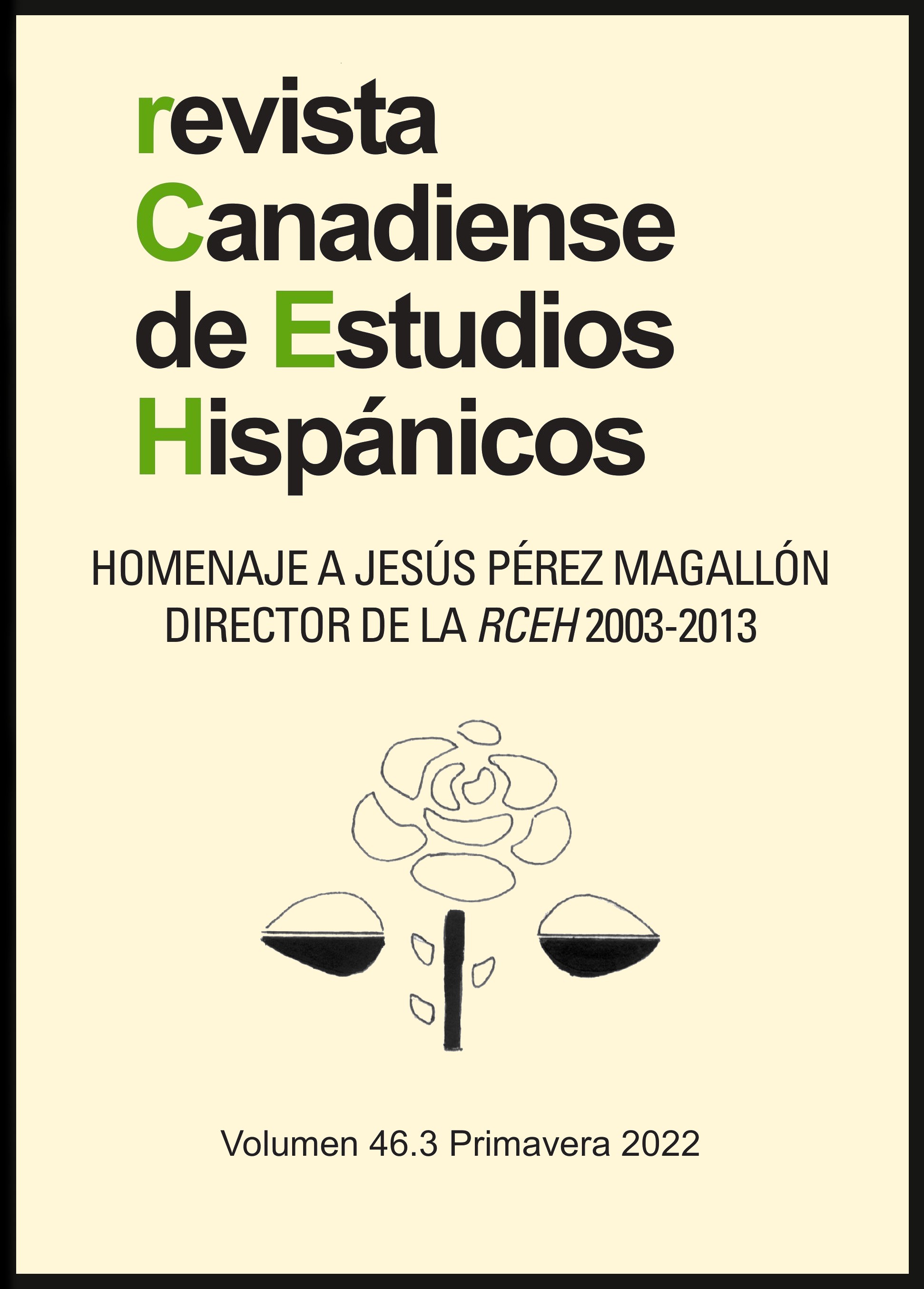La ficcionalidad crucificada en La fuerza de la sangre: una lectura batailleana de Cervantes
DOI:
https://doi.org/10.18192/rceh.v46i3.7085Keywords:
force, Cervantes, rape, queer temporality, prostitute, Virgin MaryAbstract
Taking the cross as a fictional structural device, this article reads Cervantes’s text from an anthropological perspective that questions violence against female bodies. Leocadia, as a paradigm of the Virgin Mary, takes the cross as payment for Rodolfo’s rape, putting her in the position of a prostitute. For Bataille, prostitutes had sacred characteristics because they were permanently transgressing limits. Through repetitive fainting and the theft of the crucifix, Leocadia experiences a queer temporality that grants her access to the sacred. Leocadia’s scientifically impossible pregnancy frames this text as a miracle narrative that questions the use of the crucifix to justify rape.
References
ARISTÓTELES. Física. Trad. José Luis Calvo Martínez y José Manuel García Valverde. Madrid: Consejo Superior de Investigaciones Científicas, 2022.
ALLEN, JOHN J. “El Cristo de la Vega and La fuerza de la sangre.” MLN 83.2 (1968): 271-75.
BAINES, BARBARA J. “Effacing Rape in Early Modern Representation.” ELH 65.1 (1998): 69-98.
BATAILLE, GEORGES. El erotismo. Trad. Antoni Vicens y Marie Paule Sarazin. Barcelona: Tusquets, 1997.
BATAILLE, GEORGES. Visions of Excess. Selected Wrtings, 1927-1939. Ed. Allan Soteki, Carl R. Lovitt, y Donald M. Leslie, Jr. Minneapolis: U of Minnesota P, 1996.
BRACTON, HENRY DE, D. ET AL. Bracton on the Laws and Customs of England. Trad. Samuel E. Thorne 4 vols. Cambridge, MA: The Selden Society and Harvard UP, 1968.
BRUHIER, JACQUES-JEAN. Dissertation sur l’incertitude des signes de la mort. 2. Ed. París, 1749.
CALCRAFT, R.P. “Cervantes’s La fuerza de la sangre.” BHS, 58.3 (1981): 197-204.
CALDERÓN DE LA BARCA, PEDRO. La devoción de la cruz. Ed. Manuel Delgado. Madrid: Cátedra, 2004.
CASALDUERO, JOAQUÍN. Sentido y forma de las novelas ejemplares. Madrid: Gredos, 1962.
CERVANTES, MIGUEL DE. Novelas ejemplares. Ed. Harry Sieber. Madrid: Cátedra, 2000.
CULLER, JONATHAN. On Deconstruction. Theory and Criticism After Structuralism. Ithaca: Cornell UP, 1982.
“Designio.” Diccionario de Autoridades. Edición Facsímil. Editorial Gredos, 1964.
DINSHAW, CAROLYN. How Soon is Now? Medieval Texts, Amateur Readers, and the Queerness of Time. Durham: Duke UP, 2012.
EL SAFFAR, RUTH. Novel to Romance. A Study of Cervantes’s Novelas ejemplares. Baltimore: John Hopkins UP, 1974.
FAJARDO, SALVADOR J. “Space in ‘La fuerza de la sangre.’” Bulletin of the Cervantes Society of America 25.2 (2006): 95-117.
FORCIONE, ALBAN K. Cervantes and the Humanist Vision: A Study of Four Exemplary Novels. Princeton: Princeton UP, 1982.
FREEMAN, ELIZABETH. Time Binds. Queer Temporalities, Queer Histories. Durham: Duke UP, 2010.
LE GOFF, JACQUES. “Church Time and Merchant Time in the Middle Ages.” Social Science Information 9.4 (1970): 151-67.
HEYSE, PAUL, Y HERMANN KURZ. Deutscher Novellenschatz. Munich: Rudolph Oldenbourg, 1969.
HUARTE DE SAN JUAN, JUAN. Examen de ingenios para las ciencias. Ed. Guillermo Serés. Madrid: Cátedra, 1989.
LAQUEUR, THOMAS. La construcción del sexo. Cuerpo y género desde los griegos hasta Freud. Trad. Eugenio Portela. Madrid: Cátedra, 1994.
LAPPIN, ANTHONY. “Exemplary Rape. The Central Problem of La fuerza de la sangre.” A Companion to Cervantes’s Novelas ejemplares. Ed. Stephen Boyd. Woodbridge: Tamesis, 2005. 149-71.
LEFERE, ROBIN. “‘La fuerza de la sangre’: Historia de una lectura.” RILCE 10.2 (1994): 63-81.
LEWIS-SMITH, PAUL. “Fictionalizing God: Providence, Nature, and the Significance of Rape in La fuerza de la sangre.” MLR 91.4 (1996): 886-97.
“Medios.” Diccionario de Autoridades. Edición Facsímil. Editorial Gredos, 1964.
MUIR, KENNETH. “Hardy, Middleton, Calderón and Cervantes’ La fuerza de la sangre.” Elizabethan and Modern Studies. Presented to Professor Willem Schrickx on the Occasion of his Retirement. Ed. J. P. Vander Motten. Gent: Seminarie voor Engelse en Amerikaanse Literatuur, R.U.G., 1985. 181-89.
RHODES, ELIZABETH. “Living with Rodolfo and Cervantes’s ‘La fuerza de la sangre.’” MLN 133.2 (2018): 201-23.
SÁNCHEZ, FRANCISCO J. Lectura y representación. Análisis cultural de las Novelas ejemplares de Cervantes. Nueva York: Peter Lang, 1993.
TEUBER, BERNHARD. “Die Evidenz des blutigen Leibes und das christliche Imaginarium in La fuerza de la sangre – Plädoyer für die theopoetische Lektüre einer cervantinischen Novelle.” Cervantes’ Novelas ejemplares im Streitfeld der Interpretationen. Exemplarische Einführungen in die spanische Literatur der Frühen Neuzeit. Ed. Hanno Ehrlicher y Gerhard Poppenberg. Berlín: Tranvía; Walter Frey, 2006. 68-106.
VAIPOULOS, KATERINA. “La fuerza de la sangre en el teatro del Siglo de Oro.” Theatralia 5 (2003): 431-39.
VENETTE, NICHOLAS. Conjugal Love; or the Pleasures of the Marriage Bed Considered in Several Lectures on Human Generation. Londres: Printed for the Booksellers, 1750.
WELLS, MARCIA L. “Violence Disguised: Representation of Rape in Cervantes’s La fuerza de la sangre.” Journal of Hispanic Philology 13.3 (1989): 240-52.
WIECHENS, PETER. Bataille zur Einführung. Munster: Junius, 1995.
Published
Issue
Section
License
Copyright (c) 2024 Patricia Saldarriaga

This work is licensed under a Creative Commons Attribution 4.0 International License.
Aquellos/as autores/as que deseen publicar en la RCEH o tengan publicaciones en esta revista aceptan los siguientes términos:
- La RCEH solo publica artículos inéditos.
- Los artículos enviados a la RCEH no deben estar bajo consideración en ninguna otra revista o editorial.
- Los/as autores/as podrán incluir imágenes cuando las consideren esenciales para su estudio. Es responsabilidad suya el obtener por escrito la autorización para su reproducción y presentarla a la RCEH.
- Los/as autores/as conservarán sus derechos de autor y garantizarán a la RCEH el derecho de primera publicación de su obra, el cuál estará simultáneamente sujeto a la Licencia de reconocimiento de Creative Commons que permite a terceros compartir la obra siempre que se indique su autor y su primera publicación en la RCEH.
- 12 meses después de la publicación de su obra en la RCEH, los/as autores/as podrán adoptar otros acuerdos de licencia no exclusiva de distribución de la versión de la obra publicada (p. ej.: depositarla en un archivo telemático institucional o publicarla en un volumen monográfico) siempre que se indique la publicación inicial en esta revista.


